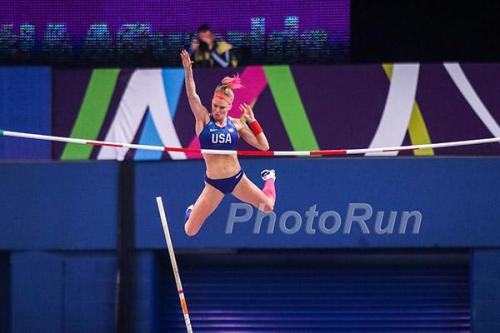 Sandi Morris, photo by PhotoRun.net
Sandi Morris, photo by PhotoRun.net
Original Post on March 3, 2018
RelatedPosts
Repost December 31, 2018
This was one of the most exciting events of the championships. Stuart Weir helped us out through all of 2018 as I was recovering from April to October. Stuart has a fine sense of humor, which shows up in his columns.
I was watching Sandi Morris’ last jump from the BBC radio live row in the media section. Ed Harry was calling the jump and it was truly exciting. With Ed Harry covering the vault, it allowed me to appreciate the tension and emotion in the tremendous vault competition at Birmingham. Here is Stuart Weir’s comments on the amazing pole vault!
A great pole vault competition.
There have been many great events this weekend but it is hard to think of a more exciting competition than the Women’s Pole vault. Christian Coleman had to “work” for just over 6 seconds to win his 60m gold medal. Sandi Morris was out there for 3 hours to win hers.
Two streaks came to an end. Katerina Stefanidi, the reigning World outdoor and Olympic champion, was finally beaten after a winning streak of 19 competitions. Sandi Morris broke a less welcome streak – silver at the Worlds Championships (indoor and outdoor) and the Olympics.
Pole vault involves running with a pole and vaulting over a high bar. It involves a lot more than that! An elite competition is often two competitions in one, with the event over for some athletes before others have started. When Stefanidi entered the competition at 4.70, others had been jumping for an hour and a quarter. When Stefanidi cleared 4.70 and moved on to 4.75, only six competitors of the original 12 were still standing – or still vaulting.
Morris recently explained to me her approach to the tactics of the event: “The general rule of thumb for me has been to enter the competition about 30 centimetres under my PB. At this point, with my PB at 5.00m, that is still pretty high so I like to enter the competition at 4.40m or 4.50m. [In Birmingham she came in at 4.50]. If I am feeling really good I may pass a bar. It really depends on an athlete’s confidence because that really is the key to making bars at the first attempt, trusting that you are doing the right thing. Having the right coaching, what pole to start with and so on, are also factors. You also go off your warm-up. If I have a bad warm-up, I might come in a bit lower and jump more bars to get myself into a rhythm. That is my tactic”.
Morris prides herself on her fitness and therefore, her ability to vault as many times as she needs to: “Some athletes are better at the beginning and the more jumps they take, the worse they get. But I like to jump a lot of heights. The more jumps I take, the better my technique seems to get”.
That begs the question: how many vaults is an athlete capable of in a competition? Surely there must be a limit to the number of jumps one is physically able to take?
“I think it all comes down to age and how you train,” she explained. “I am still very young. In practice I will take 20 full-approach jumps – that is a lot of jumps. I am pretty proud that I once got PRs on a 15th and 16th jump of my competition. For some reason I was making everything on the third attempt but I just kept on fighting and suddenly I hit two PRs in a row.”
Adding that her training is especially tough. “I suppose how many jumps you can take depends on how physically fit you are. My coach gets us very fit. We train really, really hard. I would say we train hardest of all the pole vaulters in the world. The training is very intense, which is great when you are younger but I will have to alter everything as I get older to be able to keep my body healthy as all the years of pole vaulting will put a tax on my body.
“Coach tries to incorporate a pole into as much as possible,” she continues. “So we will do full-blown running workouts carrying a pole – not round the track but running straight – and it makes it so much more difficult doing the running with the pole. So for me, doing 10 x 100m without a pole it is not a big deal but if you put a pole in your hands you cannot pump your arms and that makes it that much harder to run the 100m. By the end of those 10 x 100m we are barely able to run and are keeling over and falling on the track.”
When I spoke to Stefanidi in Glasgow a week before Birmingham, she raised the issue of floor surface. There I was thinking that a floor was a floor! She put me right explaining that sometimes you vaulted off a runway and sometimes of “ground” [floor]. “I like competing indoors when we are going off ground”, she continued. “I have a little bit of trouble when it is race runways. On good runways it is OK but if they are not set up well, they can be too bouncy and they ruin my rhythm. Those girls [Nageotte and Morris] have done really well but they have done it on race runways and I think there is a big difference between a race runway and the ground. It will be interesting to see how they adjust to the ground, having mainly jumped off race runways. My last two meets off the ground have not been the best but at least I have got used to it”.
In the event, Nageotte did not come close to her recent PR of 4.91 but Morris made whatever surface adjustment was necessary and Stefanidi could not find her best form.
In Glasgow Stefanidi had shared with me her strategy for championships: “I always say, going into a championship, if you can jump 4.85 you will get a medal. If you can do it on the first attempt, you will get gold”. In Birmingham Anzhelika Sidorova cleared 4.85 first time while Morris and Stefanidi both passed after first time misses at 4.85. [Stefanidi had only cleared 4.80 at the third attempt, 4.75 at the second]. So Stefanidi’s formula did not work this time as Morris won with 4.95, Sidorova was second with 4.90 and Stefanidi third with 4.80
My only reservation about an absorbing contest was the stadium announcers often seems to be sharing fairly trivial facts about a particular race instead of directing attention to the pole vault. In fact the trivial race facts were sometimes being shared while a vaulter was on the runway (or even the floor).
Finally – and no article on Sandi Morris should be without it – I need to mention that Morris is theonly one of the three medallists with pet snakes! “At the moment I just have three snakes,” she told me. “At one time in my life I had 28. My lifestyle as a travelling athlete makes it very hard to have 28 and I had to cut it down to three. I have two red tail boas and a ball python. Those are very common, harmless snakes. They are just pets. The ball python I have had since I was 11 years old. The others I have had for three and five years so they are the ones I am emotionally attached to”.
Author
-

Since 2015, Stuart Weir has written for RunBlogRun. He attends about 20 events a year including all most global championships and Diamond Leagues. He enjoys finding the quirky and obscure story.
View all posts





















